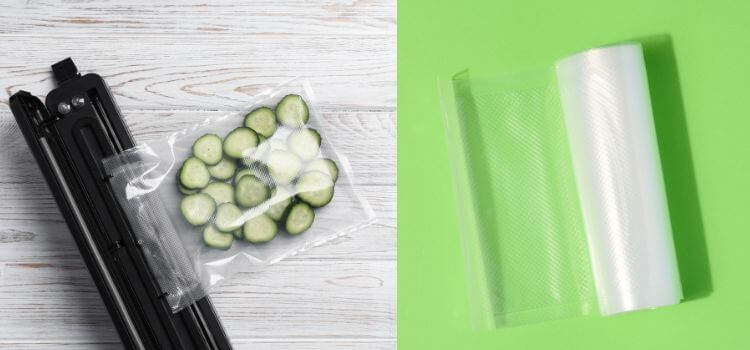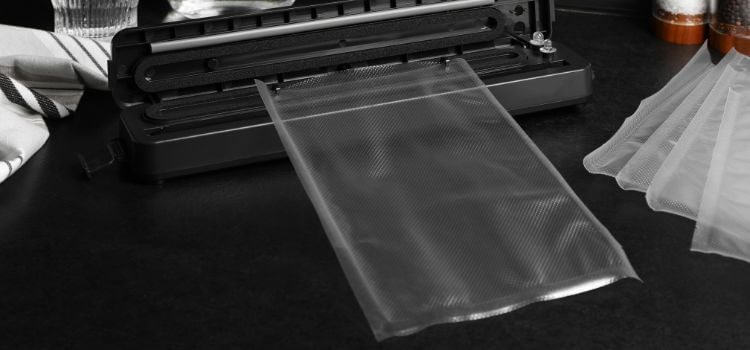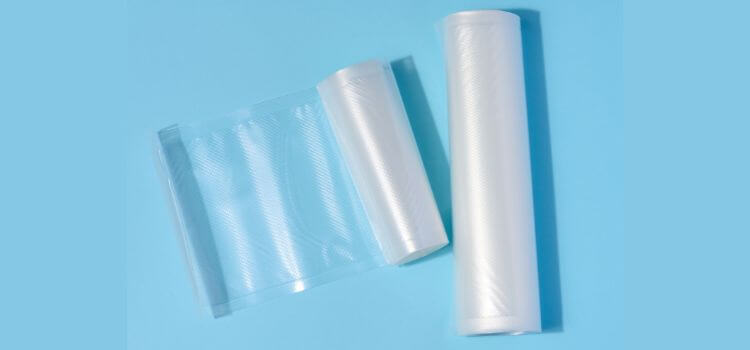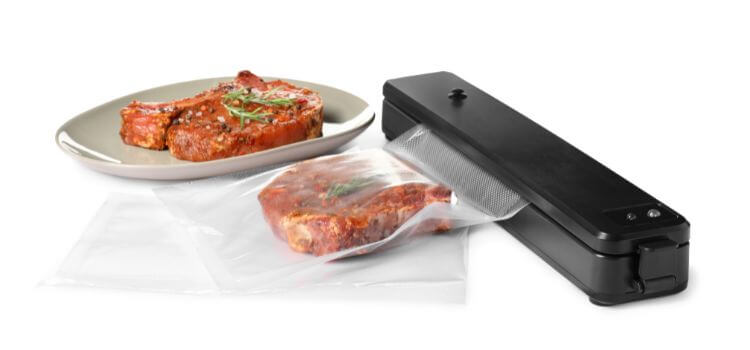As an Amazon Associate, I earn from qualifying purchases

The debate between vacuum sealer bags and rolls rages on when preserving food freshness and extending shelf life.
In this thorough guide, we explore the complexities of each option in detail, weighing their advantages and disadvantages to assist you in making an informed choice for your food storage needs. Stay tuned to discover the ultimate choice for keeping your food fresh longer!
What are Vacuum Sealer Bags?

Vacuum sealer bags are specially designed, airtight pouches used to store and preserve food with the help of a vacuum sealing machine. These bags are usually crafted from premium plastic materials like polyethylene or polypropylene, which have excellent oxygen barrier properties that help maintain the freshness of food by eliminating air exposure.
The vacuum sealing process involves removing air from inside the bag, creating an airless environment that inhibits the proliferation of bacteria and other microorganisms that cause food spoilage. This process also helps to maintain the natural flavours and textures of food, making vacuum sealer bags a popular choice for storing meats, vegetables, fruits, and even liquids.
Pros and Cons of Vacuum Sealer Bags
Pros:
- Excellent air and moisture barrier properties
- Versatile and ideal for a diverse array of foods and liquids
- Easy to use with a vacuum sealing machine
- Reusable and durable, creating less waste compared to other storage options
Cons:
- It may be costlier than conventional storage bags or containers.
- It may not be suitable for storing bulky items or irregularly shaped food items
- Requires a vacuum sealing machine, an additional cost for some users
Examples of popular brands/models of vacuum sealer bags
- FoodSaver Vacuum Sealer Bags
- NutriChef Vacuum Sealer Bags
- Weston Vacuum Sealer Bags
What are Vacuum Sealer Rolls?

Vacuum sealer rolls are similar to vacuum sealer bags but have a key difference – they come as continuous rolls instead of pre-cut pouches. This allows users to customize the size of the bag according to their needs, making it a more versatile option for storing different types and sizes of food items.
Like vacuum sealer bags, these rolls are made from high-quality plastic materials with excellent barrier properties that help to preserve food freshness. The process of removing air and sealing the bag is also the same, where users can use a vacuum sealing machine or manual hand pump.
Pros and Cons of Vacuum Sealer Rolls
Pros:
- Versatile, customizable size for different food items
- It can be more cost effective for larger food items or batches
- Suitable for irregularly shaped or bulky food items
Cons:
- Requires a vacuum sealing machine or manual hand pump
- It may not be as airtight compared to pre-cut bags
Examples of popular brands/models of vacuum sealer rolls
- FoodVacBags Vacuum Sealer Rolls
- NESCO Vacuum Sealer Rolls
- GERYON Vacuum Sealer Rolls
Key Differences Between Bags and Rolls
- Storage capacity and customization: The main difference between vacuum sealer bags and rolls is the storage capacity and customization options. While bags come in pre-cut sizes, rolls can be cut to any desired length, making them more versatile for storing larger or irregularly shaped food items.
- Cost-effectiveness: Regarding cost-effectiveness, vacuum sealer rolls may be a better option for those who frequently seal large batches of food. However, for smaller quantities, bags may be a more affordable choice.
- Ease of use: Both vacuum sealer bags and rolls require a vacuum sealing machine or hand pump for the sealing process. However, some users may find it easier to use pre-cut bags as they eliminate the need for measuring and cutting, while others may prefer the versatility of rolls.
- Environmental impact: Regarding environmental impact, vacuum sealer rolls may have a slight advantage over bags due to their customizable size and potential for less waste. However, both options are considered more sustainable than traditional plastic storage bags or containers.
- User-friendliness and practicality: Both bags and rolls have their advantages in terms of user-friendliness and practicality. Pre-cut bags may be more convenient for quick storage, while rolls offer more versatility and customization options.
Best Practices for Using Bags and Rolls

Proper techniques for sealing food using bags:
- Ensure the food is completely dry before placing it in the bag to avoid moisture buildup.
- Leave enough space at the top of the bag for proper sealing, typically about 3 inches.
- Place the open end of the bag into the vacuum sealing machine and press down to create a tight seal.
- Once sealed, store your food in a cool, dry place for optimal freshness.
Proper techniques for sealing food using rolls.
- Measure and cut the desired length of the roll, leaving an additional 3-4 inches on each end for sealing.
- Place one end of the roll into the vacuum sealing machine and press down to create a tight seal.
- Fill the bag with your food items, leaving enough space at the top for proper sealing.
- Place the open end of the bag into the vacuum sealing machine and press down to create a tight seal.
- Once sealed, store your food in a cool, dry place for optimal freshness.
Conclusion
Vacuum sealer bags and rolls are excellent options for preserving fresh food and reducing waste. While they have their own unique features and benefits, ultimately, the choice between bags or rolls will depend on personal preference and the type of food items being stored.
Whichever option you choose, following proper techniques and using premium materials guarantees optimal results for your vacuum sealing needs. So, choosing a reliable and reputable brand for the best results is important. Happy vacuum sealing!
As an Amazon Associate, I earn from qualifying purchases